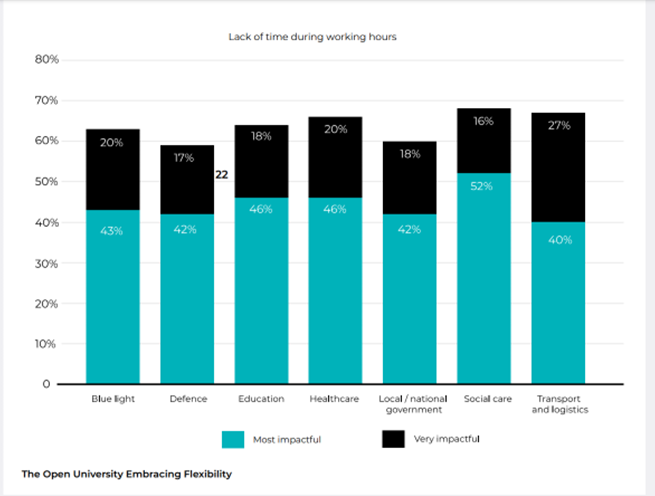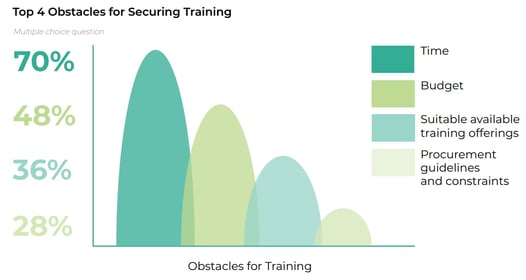Barriers to Learning at Work: What They Are and How to Overcome Them
 Chloe Martin
·
5 minute read
Chloe Martin
·
5 minute read
No matter how eager your employees are to learn, they could still face barriers to learning at work that can stop them from getting started.
We’ll cover the most common barriers to learning, how to overcome them and what you can do to help employees move past these hurdles as an L&D professional. We'll also dive into the other side of learning, securing training and the barriers L&D teams can face in central government.
Contents:
- 8 Barriers to Learning at Work For Employees and How to Overcome Them
- Top 4 Barriers to Securing Training in Central Government
- Uncover L&D Insights in Central Government with our White Paper
What Could be Preventing Your Employees From Learning?
Although we have more technological advancements allowing many of us to “learn and work from anywhere,” there are still barriers to overcome when it comes to encouraging employees to start learning in the workplace. If you’re designing a shiny new learning program, the last thing you want is barriers to get in the way.
8 Barriers to Learning at Work and How to Overcome Them
1. Lack of Time / Busy Schedules
A recent collaborative report and survey on Embracing Flexibility in the public sector by Public Sector Executive (PSE) and The Open University, discovered that 46% of respondents said they couldn’t take part in learning due to not having enough time.
Each organisation in the public sector will have different needs and availability when it comes to learning. 60% of those in social care stated they were prevented from taking part due to a lack of time.
Even attending something as short as a quick lunch break coaching session could prove problematic for some sectors. This is not a new problem, but now we have more learning options, such as job-related learning or long-term flexible learning time to fit the needs of services and employees, things could look strong for the future.
2. Inflexible Working Hours
29% (three in ten) of survey respondents were prevented from taking up learning due to inflexible working hours. In the education sector especially, 38% said a lack of flexible working hours, particularly because of how work is timetabled, prevents and limits their opportunities to take part in learning and improve their personal development.
Now we have flexible and distanced learning, there’s a higher chance of planning dedicated learning time around the particular individual. As an L&D professional, it’s up to you to make sure the quality of online content is right and positively reflected against other or more traditional formats of learning, e.g. face-to-face.
Flexibility isn’t just the key when it comes to effective L&D, it’s also the top employee benefit.
3. Lack of Technical Skills
Not all staff will be technology whizzes when it comes to online learning platforms. In this case, try to find out which employees are finding online learning platforms challenging and why. You can show them how best to navigate the platform and give them the knowledge they need to complete the portals with confidence.
If they continue to find this format of learning difficult, offer them more traditional learning tools such as face-to-face mentoring or external-led courses. If you’re stuck for other formats, ask them to shadow another employee for an online training session to make sure they’ve really got the hang of the platform.
Read: 4 steps to futureproof your learning and development strategy
4. Peer Pressure
Whether senior management would like employees to focus on a specific skill or training managers are under pressure to achieve unattainable development goals, employees are likely to get the backlash of this by feeling peer pressured into completing training they’re uninterested in just for the sake of training.
Find out what your employees would like to work on and what they expect before you conduct training. Then afterwards, send out a survey to receive feedback on the training, whether it met their needs, how you can tailor the training to further meet their needs and if the training was right for their schedule and working pattern.
5. Lack of Format Choice
There are various types of learning formats to choose from, such as internally organised masterclasses, eLearning, short-term courses or accredited professional qualifications. But do you know what type of learning formats your employees prefer? Which one makes them most engaged? According to the Embracing Flexibility report, 63% of public sector respondents said they plan or would like to participate in short courses and masterclasses.
Make sure your employees know what learning formats are available to them. If there is a lack of awareness of the types of learning available, you’re missing out on an opportunity for your organisation and staff to develop their skills and grow. To find out what your employees would prefer, take the time to talk to them, send out a survey or open up a discussion with your team or departments.
Looking to evaluate your learning and development initiatives? Here are 4 proven models that can help.
6. An Underdeveloped Learning Culture
A learning culture is one that prioritises learning and embeds this at all levels – individual, team and the wider organisation. If learning at work has never been reinforced in your employee’s working culture, it might be hard to develop a continuous learning habit – but never impossible!
A thriving learning culture survives off the employee's understanding of the benefits of learning and how it can positively impact their well-being and productivity. To overcome this barrier, start by leading by example. Show senior leaders taking part in training and open conversations about skill improvement. Encourage knowledge sharing throughout all levels of the organisation which will help make learning a core value to your employees.
7. Unnecessarily Complex Learning Program
Whether you’re jamming too many topics and new skills into one learning program, or it’s overly difficult for employees to follow, it’s likely you won’t get much uptake. Make the learning program as simple as possible to follow with clear signs to the next steps and various learning formats to choose from to suit the individual’s work week.
8. Lack of Goals for Learning
Every training program you set should have clear outcomes and goals attached to it to help employees understand the benefits and why it should be a priority. Allow your employees to select what topics interest them, and ensure that it’s relevant and matches their needs. This helps to make the learning process more personalised and will motivate employees to get into a habit of continuous learning and consistently reach their desired learning outcomes.
Setting goals is a great way to promote productivity and focus employees. Learn how to set effective SMART goals here.
Aside from barriers your employees may face when it comes to learning at work, we understand that L&D teams also face barriers when securing training.
In our latest white paper, Learning and Development in Central Government: 2023 Trends and Future Challenges', we surveyed L&D professionals from 93% of ministerial and non-ministerial government departments to find out the latest L&D trends, challenges, training initiative effectiveness and more.
Here are the top four barriers L&D professionals in central government face when securing training for their team.
Top 4 Obstacles for Securing Training in Central Government
- Time (70%)
- Budget (48%)
- Suitable available training offerings (36%)
- Procurement guidelines and constraints (28%)
Our results show that one of the biggest barriers to learning across government departments is not having or making enough time for learning. With already over-stretched workloads and reduced headcounts still recovering from the pandemic, taking the time to attend training is less of a priority. Working from home can also create barriers to learning if L&D teams wish for employees to attend face-to-face training.
A lack of time and restrictive procurement constraints make creating a learning culture more difficult and put pressure on the training quality to engage staff and create positive outcomes every time.
Discover More L&D Insights with Our White Paper
To find out what drives training, top L&D challenges and emerging trends that could have a big impact on roles in the future, download your copy of our latest white paper using the button below.
2+ years in SEO and content marketing. Striving to help public sector professionals develop their skills and learn something new through high-quality content.









.jpg)